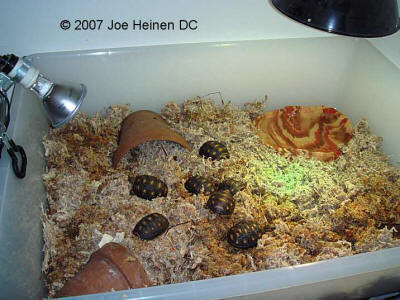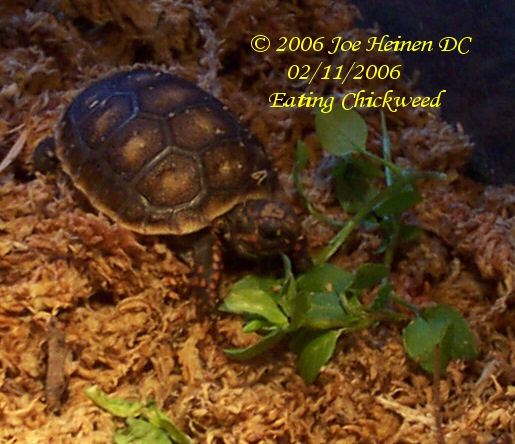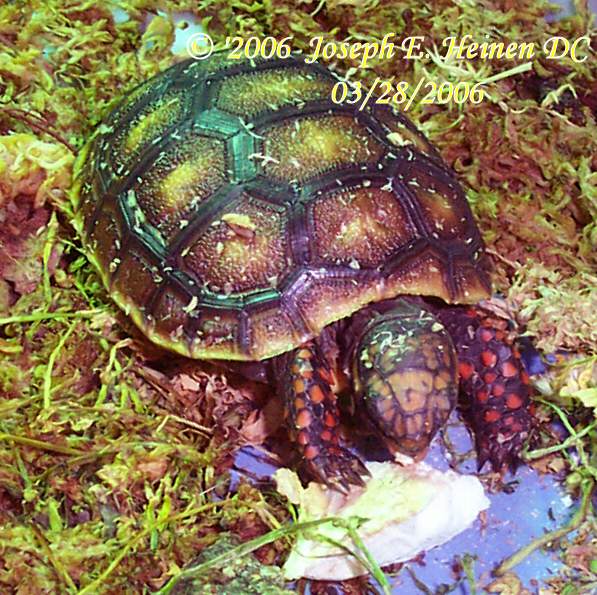Hatchling and Juvenile Care
The needs of redfoot hatchlings and juveniles are similar fashion to that of adults. However they are much more sensitive to drafts and dehydration. Breeders often keep them on dry substrates and feed improperly which leads to pyramiding at an early age. My first ones were purchased at a reptile show. They were barely 4" and had considerable pyramiding. After 7 years of proper care, they are now 9-11" long. The initial pyramiding is still evident, but new growth is smooth.
Housing:
I have found that a bus boy bin is the ideal first home. If you can't find one of those, use a cement mixing tray (found at Home Depot and Lowes). The inside diameter is 19" long. 15" wide and 7" deep. The size is ideal for good air circulation and the color (opaque grey) seems to give the redfoot hatchlings a sense of security
Once they are bigger, Rubbermaid storage bins work well.

Click on the picture to view
full size
Substrate:
For redfoot hatchlings, I prefer sphagnum moss. I get the high quality New Zealand sphagnum moss sold for orchid growing. I keep it fairly wet. The hatclings dig through it as well as sit on top basking. After the first year, I switch them to a 50/50 mix of play sand and coconut coir (Bed-A-Beast) . I keep a pile of damp sphagnum on top which they gradually mix into the substrate.
Lighting and Heat:
Lighting is very important for normal growth and behavior. Some of the better lighting is the new ZooMed Powersun bulbs (click here for a comparison). These are used extensively in zoo's. The 100 watt flood is the most commonly used. While they do put out heat you may need to add a ceramic heat emitter to get the right temperature. Also make sure to get a good clamp on light fixture with a ceramic socket that is rated for the wattage bulb you buy.. Home Depot has them for about 10 bucks. Whenever I use a clip on fixture, I always use a "C" clamp to anchor it. The Powersun bulbs can be bought at Carolina Pet Supply .
For heat I use a 100 watt ceramic heat emitter. I use a thermostat to keep the temps on the cool end in the lower 70's. Some feel that the temps should always be in the 80's, however I have found they do better with lower temps as long as they have a basking spot of about 90°F. I check frequently with an infrared temp gun. I also use an electronic max/min thermometer with the probe at substrate level.
Diet:
For the first few weeks after hatching, redfoot tortoises live of the yolk sac reserves. At about a week they start showing interest in greens. For the first meal I like to provide weeds such as chickweed, henbit, dandelion or plantain. At first they eat only a small amount, but as they grow their appetite grows as well.

The foundation for a healthy redfoot tortoise hatchling diet
is high calcium greens, weeds and flowers. I keep
cuttlebone with them at all times. Many feel that low fat cat
food is an important source of "animal" protein or use
commercial products such as Mazuri tortoise chow, I feel its
better to offer them a diet that is similar to what they
find in nature. Since the juveniles and adults kept in
outdoor pens readily eat inscts such as sowbugs, worms,
slugs etc, I decided to offer hatchlings high calcium
insects such as
Phoenix worms and butterworms. So far the
hatchling seems to enjoy them. I offer juveniles pinky mice
or meat (shrimp, chicken, organ meat etc) every few weeks.
|
|||||||||||||
|
|
|||||||||||||
Juveniles are fed fruit a few times a week. Favorites are papayas and mangos. But, since fruit can lead to intestinal upset. I won't offer fruit to the hatchlings until they are older.
Redfoot adults are known for liking tight fitting hide areas. Hatchlings are no exception .

There are at least 10 in this hide. Its actually
dark in there, but I used the flash so they could be seen


